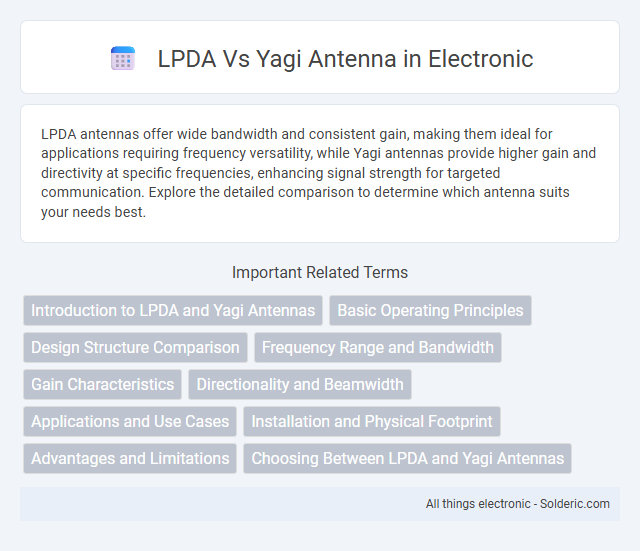LPDA antennas offer wide bandwidth and consistent gain, making them ideal for applications requiring frequency versatility, while Yagi antennas provide higher gain and directivity at specific frequencies, enhancing signal strength for targeted communication. Explore the detailed comparison to determine which antenna suits your needs best.
Comparison Table
| Feature | Log-Periodic Dipole Array (LPDA) | Yagi Antenna |
|---|---|---|
| Frequency Range | Wideband, covers multiple frequencies | Narrowband, optimized for a single frequency |
| Gain | Moderate gain (6-10 dBi) | High gain (10-20 dBi) |
| Bandwidth | Broad bandwidth (up to several octaves) | Narrow bandwidth (usually less than 10%) |
| Design Complexity | Complex element spacing and sizing | Simple design with fixed element lengths and spacing |
| Beamwidth | Wide beamwidth (40deg-70deg) | Narrow beamwidth (20deg-40deg) |
| Application | Broadband scanning, TV antennas, HF/VHF/UHF use | Point-to-point communications, radar, amateur radio |
| Impedance | Approximately 50 O, relatively constant | Varies with frequency, typically around 20-30 O |
| Physical Size | Larger due to multiple elements and spacing | More compact for given frequency |
Introduction to LPDA and Yagi Antennas
LPDA (Log-Periodic Dipole Array) antennas provide wideband frequency coverage with relatively constant gain, making them ideal for applications requiring multi-frequency operation. Yagi antennas consist of a driven element, reflector, and multiple directors, designed for high gain and directivity in a narrow frequency range. LPDA offers versatility in broadband signals, while Yagi excels in focused transmission and reception at specific frequencies.
Basic Operating Principles
The Log-Periodic Dipole Array (LPDA) antenna operates based on a series of dipole elements of varying lengths spaced logarithmically along a boom, allowing it to maintain consistent impedance and gain over a wide frequency range. The Yagi antenna features a driven element, reflector, and multiple directors arranged linearly to focus energy in a specific direction, enhancing gain and front-to-back ratio but limiting bandwidth. LPDA antennas provide broadband performance due to their frequency-independent design, while Yagi antennas deliver higher gain in narrowband applications through resonant coupling of elements.
Design Structure Comparison
Log-Periodic Dipole Array (LPDA) antennas feature a series of dipole elements with varying lengths and spacing arranged along a boom, enabling wideband frequency coverage due to their self-similar, tapered design. In contrast, Yagi antennas consist of a driven element, a reflector, and multiple parasitic director elements, all of fixed lengths optimized for narrowband performance and high gain in a specific direction. The LPDA's structurally repetitive and scaled elements provide broadband versatility, while the Yagi's fixed element dimensions focus on maximizing directivity and gain within a limited frequency range.
Frequency Range and Bandwidth
LPDA antennas offer a significantly wider frequency range and broader bandwidth compared to Yagi antennas, making them ideal for applications requiring multi-band or wideband performance. Yagi antennas, while highly directional and efficient, typically operate within a narrower frequency range optimized for a specific band. Your choice depends on whether broad frequency coverage or narrow, high-gain performance is more critical for your application.
Gain Characteristics
LPDA antennas exhibit a moderate gain typically ranging from 6 to 9 dBi across a wide frequency band, providing consistent performance suitable for broadband applications. Yagi antennas offer higher gain, often between 10 to 18 dBi, concentrated over a narrower frequency range, making them ideal for targeted, high-gain directional communication. The choice between LPDA and Yagi depends on the trade-off between bandwidth and gain, where LPDA favors wideband utility and Yagi maximizes gain in a specific direction.
Directionality and Beamwidth
LPDA antennas feature wide bandwidth and moderate directionality with a beamwidth typically ranging from 60 to 90 degrees, making them suitable for applications requiring broad coverage. Yagi antennas provide higher directionality and narrower beamwidths, often between 30 to 60 degrees, which enhances signal gain and reduces interference from unwanted directions. The choice between LPDA and Yagi antennas depends on the need for broader frequency response versus focused signal reception.
Applications and Use Cases
LPDA antennas excel in broadband applications such as spectrum monitoring, electronic warfare, and signal intelligence due to their wide frequency coverage and consistent performance. Yagi antennas are preferred for point-to-point communication, TV reception, and amateur radio where high gain and narrow bandwidth are essential. Both antenna types serve distinct use cases based on frequency range, directionality, and gain requirements in communications and signal detection systems.
Installation and Physical Footprint
LPDA antennas feature a compact, lightweight design with elements arranged in a tapered, logarithmic pattern, making installation easier on rooftops or confined spaces compared to the longer boom and uniform element spacing of Yagi antennas. Yagi antennas typically require more mounting height and structural support due to their larger physical footprint and directional beamwidth, which can impact tower load and wind resistance. The LPDA's streamlined form factor reduces spatial constraints and allows for quicker setup in urban or limited-area environments.
Advantages and Limitations
LPDA (Log-Periodic Dipole Array) antennas offer wide frequency coverage and consistent gain over a broad spectrum, making them ideal for applications requiring multi-band operation and frequency agility. Yagi antennas provide higher gain and better directivity at specific frequencies, suited for point-to-point communication but suffer from narrow bandwidth and limited frequency flexibility. Limitations of LPDA include generally lower gain compared to Yagi antennas, while Yagis have reduced performance outside their design frequency and larger physical size for broadband needs.
Choosing Between LPDA and Yagi Antennas
Choosing between LPDA and Yagi antennas depends on the specific application and frequency range requirements. LPDA antennas offer wider bandwidth and consistent gain across a broad frequency spectrum, making them ideal for applications requiring multi-band operation. Yagi antennas provide higher gain and more focused directional performance over narrower frequency ranges, benefiting long-distance point-to-point communications.
LPDA vs Yagi antenna Infographic

 solderic.com
solderic.com